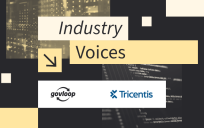This blog post is an excerpt from a sponsor of our latest IT modernization guide.
Agencies today understand the need and the drive for IT modernization and consolidation – and now, they can start to reap the benefits. In fact, agencies that modernize and consolidate IT experience a variety of advantages, including lower costs, more efficiency, greater availability, and improved compliance and security.
But that doesn’t mean the process is easy. In fact, as agencies move through the process, the complexity of IT environments increases significantly and the responsibility of managing both legacy infrastructure and upgraded systems creates burdens.
So how can agencies successfully modernize and consolidate their IT? To learn how, GovLoop sat down with Paul Parker, Chief Technologist, Federal and National Government, SolarWinds, a leader in IT management. SolarWinds works with DLT, SolarWinds’ federal distributor, and other federal partners to offer IT management and monitoring solutions for networks, applications and servers, cybersecurity and more.
According to Parker, there are five steps that can help agencies better navigate challenges and benefit from IT modernization and consolidation.
First, Parker said having a solid definition of scope is critical to a successful modernization process. “Defining the scope requires figuring out what challenges we want to solve and why, as well as the timeline and budget,” he explained. Doing so can help organizations understand the constraints of a project, so agencies can better avoid underestimating its complexity.
Next, “You absolutely need to know where you are starting from,” Parker said. Parker compared the process to building a home. “Is the foundation of the house already established, are the walls up and you just have to add the roof? Or, have you not even done a site survey to identify where you will build the home?” Find the baseline of your agency’s IT resources. Take the time to find what you already have in place, specifically regarding tools, policies, and procedures.
After the inventory, conduct a needs analysis. Does your agency have everything it needs to move forward with modernization and consolidation? Look for tools that can drive the most efficiency in your agency’s modernization project based on the inventory’s findings.
In your fourth step, survey the market. Research market standards regarding tools and services. Consider hybrid cloud infrastructures of different products for shared services. Who are the players and what are the differentiators between IT solutions? In addition to government, DLT also examines commercial market segments such as finance and that are focused on modernization projects of similar size, complexity, and level of importance.
Lastly, move forward. “As you’re picking through each of these steps, you should be getting closer and closer to what you’re hoping to accomplish,” Parker said. At this point, identify what can be achieved most quickly from the first four steps. Then, it’s all about focusing on one thing at a time and building on that.
SolarWinds works in conjunction with these five steps by helping eliminate complexity from IT processes like network operations, resource consolidation, legacy product migration, continuous monitoring, cybersecurity, data center operations and compliance.
Parker also noted that along with complexity, IT modernization initiatives can present security challenges. But, with the right tools and planning, they can be addressed ahead of time. It’s also important to realize the abilities of automation in managing government networks when working on IT modernization.
DLT and SolarWinds can improve the security of networks by proactively highlighting security issues. Their software is designed to deliver actionable intelligence to proactively identify threats, take automated action to quarantine and mitigate damage and analyze data to prevent future attacks.
But, adhering to security protocol can be more complicated than identifying the weak spots. According to Parker, there are often communication silos between people who work in IT and those who work in information security. “The relationship can sometimes be more adversarial than symbiotic,” Parker said. “People need to learn how to embrace the needs of security practitioners and understand why it’s important to them.”
Embracing automation can improve these processes. “With automation we can take repeatable tasks and remove the interaction portion of that,” Parker said. “Those are cycles that may be better spent on more important and complex things.”
Ultimately, agencies can improve modernization efforts with the help of the five steps above, as well as a focus on security and an understanding of automation. This can help them to reap the benefits and meet missions.






Very informative and helpful–I’ll have to download the guide to get the full picture!